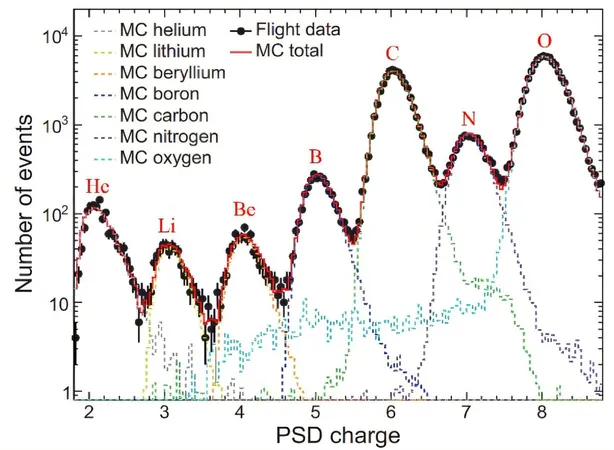
Groundbreaking Discovery: DAMPE Unveils High-Precision Cosmic-Ray Boron Spectrum
2025-07-03
Author: Wei Ling
Cosmic-Ray Breakthrough from DAMPE
In an exciting advancement for astrophysics, the Dark Matter Particle Explorer (DAMPE), also known as "Wukong," has achieved a high-precision cosmic-ray boron spectrum across an energy range of 10 GeV/n to 8 TeV/n. This milestone includes the groundbreaking identification of a spectral "hardening" phenomenon occurring around 182 GeV/n, marking a significant first in the field of cosmic-ray research.
Innovative Technology Behind DAMPE
Onboard a specially designed satellite, DAMPE is equipped with the most advanced calorimeter created from bismuth germanium oxide—allowing it to cover energy ranges more than double that of past space experiments. A key player in its success is the Plastic Scintillator Detector (PSD), designed by the Institute of Modern Physics at the Chinese Academy of Sciences, which excels in identifying cosmic-ray nuclei due to its superior charge measurement capabilities.
The Hardening Phenomenon Explained
Data analysis from DAMPE reveals a remarkable "hardening" in boron spectra near 182 GeV/n, with an impressive confidence level of eight sigma. This hardening indicates that secondary boron—created from interactions with primary cosmic rays such as carbon and helium—behaves significantly differently from its primary counterparts.
A New Understanding of Cosmic Rays
The findings from DAMPE are not just numbers; they sync with theoretical predictions that suggest cosmic-ray boron forms through fragmentation reactions with interstellar matter. The results shed light on cosmic-ray propagation processes, offering a fresh lens to refine existing theoretical models. The research team, which includes experts from various prestigious institutions like the Purple Mountain Observatory in China and the Gran Sasso Science Institute in Italy, underscores the collaborative effort in unraveling the cosmos.
Setting a New Standard in Cosmic-Ray Measurement
With these unprecedented findings, DAMPE establishes a new benchmark for measuring cosmic-ray energy spectra at TeV energies, igniting interest and potential for future research in cosmic-ray physics. As scientists continue to decode the mysteries of the universe, discoveries like these pave the way for deeper insights into the fundamental processes of our cosmos.

 Brasil (PT)
Brasil (PT)
 Canada (EN)
Canada (EN)
 Chile (ES)
Chile (ES)
 Česko (CS)
Česko (CS)
 대한민국 (KO)
대한민국 (KO)
 España (ES)
España (ES)
 France (FR)
France (FR)
 Hong Kong (EN)
Hong Kong (EN)
 Italia (IT)
Italia (IT)
 日本 (JA)
日本 (JA)
 Magyarország (HU)
Magyarország (HU)
 Norge (NO)
Norge (NO)
 Polska (PL)
Polska (PL)
 Schweiz (DE)
Schweiz (DE)
 Singapore (EN)
Singapore (EN)
 Sverige (SV)
Sverige (SV)
 Suomi (FI)
Suomi (FI)
 Türkiye (TR)
Türkiye (TR)
 الإمارات العربية المتحدة (AR)
الإمارات العربية المتحدة (AR)